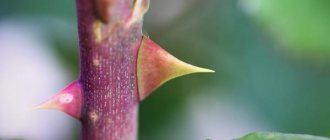What is a standard rose and how to create it
People who are far from floriculture do not know that a rose in the form of a tree is not actually one. The unusual shape is obtained by grafting roses of various varieties onto a root shoot - a trunk (this is called the trunk). Depending on its height, roses growing as a tree in the garden are of different heights.
What does a tree rose look like?
Advantages and disadvantages of this rose:
| Advantages of a standard rose | Disadvantages of a standard rose |
| more abundant flowering than the stem version; | inability to reproduce; |
| increased winter hardiness; | problems with growing rootstock. |
| highly decorative. |
For your information! In some European countries, experiments are underway on the seed method of propagating standard roses. And success has already been achieved for some varieties.
Basic Description
The rose acquired its name because of its long trunk, which is completely devoid of shoots and branches, but has a crown in the form of a cap with many flowers and leaves. The elongated section of the trunk is called a trunk .
The advantages of standard beauties are:
- The plant is highly resistant to cold and drought.
- They have a long flowering period compared to conventional varieties.
- Due to its height, the crown receives more sunlight.
- Due to the long trunk and the absence of foliage near the ground, roses are less damaged by diseases and pests.
- Takes up little space in the flowerbed.
The disadvantage is the peculiar pruning of the crown to maintain this appearance. This will require certain skills and abilities.
A tree rose is obtained by grafting a common rose onto a rose hip. Therefore, the height of the resulting plant cannot exceed 1.5 meters. The main condition for successfully obtaining a standard beauty is to grow the rootstock on rose hips.
This rose has a slightly different structure than cultivated ones. It has a root system, a long trunk (trunk) and a crown. The branches of the crown can be erect (when the scion is from cultivated varieties) or flowing (when the scion is from a climbing rose).
Description of a rose in the form of a tree
Decorative foliage begonia - growing features
Depending on the height of the trunk to which the rose is grafted, the following types of standard trees are distinguished:
- dwarf, whose height is only 30-50 cm;
- semi-standard up to 80 cm high;
- ordinary trunks, whose average height is 1.3 m;
- high-standard varieties are the tallest tree roses, the height of which can reach up to 3 m, and the branches always have a drooping shape.
Note! All grafted varieties retain their original properties.
Landing
The soil intended for filling the planting hole can be prepared on your own by mixing clay, compost, leaf and turf soil in equal proportions.
Step-by-step instruction
- At the bottom of the planting hole, which has a depth and width of 70 cm, a strong wooden peg is installed (a plastic pipe or metal rod can also be used as a support), the height of which after installation should be slightly lower than the beginning of the bush crown.
- The support peg should be located on the side from which the wind most often blows.
- The underground part of the support peg, pre-treated with an antiseptic, must be buried at least 50 cm.
- A layer of expanded clay is poured onto the bottom of the planting hole.
- By placing the stem in the very center of the planting hole, give it a slight (up to 30-450) slope in the direction opposite to the support peg.
- Having carefully straightened the root system of the seedling (it should be kept 15 cm below the soil surface), the planting hole is covered with earth, which is then compacted a little. The planted plant is watered abundantly.
- The root collar of the trunk is sprinkled with soil to a height of up to ten centimeters.
- Aerial roots located between the soil surface and the root collar must be cut off.
- The distance between adjacent planting holes must be at least one meter.
- The newly planted plant is allowed to settle in the soil at an angle for two weeks. After this time, the stem is carefully pulled up and tied to the support peg (with loops resembling a figure eight), fixing it in the middle and at the very base. To protect the bark from damage, the trunk can be wrapped in soft material at the attachment points. As the crown grows and becomes heavier, the trunk is fixed directly under it, retreating 3-4 cm from the grafting site.
Important landing nuances
- Considering the need to cover standard roses for the winter, they are planted at a slight angle towards the bend. Before planting a trunk, the grower must determine in which direction it bends best. To determine the vector of the correct bend, it is necessary to focus on the cone, which is the seal of the root collar, since it is from it that the arched origin of the trunk occurs. When planting a trunk, the convex side of the cone should be placed closer to the support peg, orienting the bush in advance in the direction of its future placement for the winter.
- You should think about the direction of laying the tree in advance: hardly anyone will like it if a bush covered for the winter blocks the path. It is best to lay the trunks towards the lawn.
- The crown of a young tree needs protection. To prevent chapping and drying out of the branches, they must be covered with a thick layer of damp sphagnum, secured with lutrasil or burlap, not forgetting to periodically moisten the protective cover and ventilate the crown. Noticing that the buds have begun to grow, the protection is carefully removed.
The most suitable varieties for tree formation
Rose Aspirin
To the question of what is the name of a rose that grows like a tree, several answers are given, because the varieties that are used for rootstock are different. Breeders distinguish 3 main types, each of which can include several varieties:
- Caninae (rose hips) is used more often than others, but has some disadvantages: slow growth, low degree of frost resistance, problems with reproduction;
- Synstylae is an unpretentious species with high immunity to diseases and pests, and the ability to adapt to most soils. It is used to breed tall rose trees;
- Indicae is used only in regions where the climate is warm and mild, since it does not tolerate cold and other climatic troubles. Its main advantage is that roses of any type can be grafted onto it.
Important! Not all varieties of roses are suitable for grafting onto a base (standard). Their number is minimal, so you should be very careful when making independent selection attempts.
Princesse de Monaco
The Princess of Monaco variety belongs to the hybrid tea group of roses. He has won many prizes at various international flower exhibitions. Description:
- the flowers are creamy white with a pink border;
- the buds are quite thick, when they bloom, it seems that they have been dipped in bright pink paint;
- As it blooms, the pink color darkens and descends throughout the petal;
- The flowers are densely double with a bright delicate aroma.
Princess de Monaco is perfect to use for a standard version.
Important! These roses are intended only for southern regions with hot, dry climates.
Princess de Monaco
Jardins de Bagatelle
Jardin de Bagatelle is also recommended for creating a standard tree. This is another variety from the hybrid tea group, the flowers of which are painted in a uniform, delicate cream color with a subtle sweet aroma.
Rose Jardin de Bagatelle
Marcel Pagnol (Marcel Pagnol)
Marcel Pagnol has another name - Scarlet Beauty, which was not chosen by chance and is ideal for this rose. And she, in turn, is ideal for growing a bright and spectacular standard tree. Description:
- the flower is recognized as one of the most beautiful and best-selling flowers all over the world;
- large buds of bright red, scarlet color with a velvety tint;
- The shape of the buds is subtle and elegant. This quality is preserved even with full disclosure.
Note! The variety is a re-blooming variety, i.e. 2 flowering periods can occur at once during a season.
Scarlet Beauty
Catherine Deneuve
This is a variety that was bred relatively recently, but has already gained popularity. It is also used as a scion to create standard roses. The buds are bright pinkish-orange. They look very impressive and will bring brightness to any garden plot, even on the gloomiest, stormy day.
Rose Catherine Deneuve
These are not all varieties that are used as standard roses, but they look very impressive and undoubtedly deserve attention.
Claude Monet
The variety is characterized by several unique properties. The most interesting thing is that during the flowering period these roses change their color. Only the blossoming petals have a pale yellow background with thick scarlet spotting. At the same time, the flowers look very elegant and, despite such a pronounced contrast, look restrained. Gradually, the color of the background and spots changes in the reverse order - the petals become pink, and the inclusions become yellow-beige.
Related article:
Why are carpet roses better than ordinary roses and why have they become so popular?
Claude Monet's aroma is also unusual. It is predominantly citrusy with subtle notes of vanilla. The variety is very resistant to infections and frost. It does not tolerate high humidity well, so it is not suitable for regions with characteristic periods of prolonged rain.
Selection of standard rose seedlings
Wild rose - what kind of flower is it, what is it called
It is preferable to buy standard roses in containers, since this is how they are more sensitive to lack of liquid. The minimum diameter of the stem should be 1 cm, for weeping high-standard roses - 2 cm.
Important! There should be no damage to the plant, even the slightest.
The crown should already be of the correct shape and have several powerful branches. In the future, it will be possible to form a beautiful dense crown if 2 buds are budded on one rootstock at once.
Europeans are luckier; in some nurseries they implant 3 buds at once. Therefore, it makes no sense to buy a plant with only 1 bud, since as it grows, it will not be possible to form a crown shape.
If you buy a seedling in a pot, then the height of the flowerpot cannot be less than 25 cm. The plant itself should be easily removed from there, and the root system should entangle the entire earthen ball.
Note! Unscrupulous nursery owners often plant the plant in a container on the eve of purchase. This is very bad.
Signs of poor quality planting and care of tree roses are:
- dry or waterlogged soil;
- presence of weeds;
- the presence of moss on the surface of the substrate.
The engraftment of a standard rose with an open root system should be given even more attention. If buds have sprouted on such seedlings or, especially, young shoots have grown, it is better not to take such a plant. And if the gardener is also a beginner, then it is worth looking for a nursery that will sell plants in pots.
Standard roses in the nursery
Use in design
Standard roses are very often used in the design of gardens, flower beds, gazebos, alleys, etc. They decorate the paths leading to the house, front areas where benches are built. The stem is beautiful both in solitaire (single) and in group plantings of several varieties of different tones. The rose on the pedestal is extremely luxurious, looking like a fountain or a volumetric layer, a descending huge vine.
Since this species is raised above the ground, it is better ventilated and illuminated, and therefore is more likely to bud. Among the total number of flowers, you will certainly highlight the standard. They can be rationally used to fill a small area.
All varieties of roses can grow on a trunk, however, in my opinion, you should take a closer look at such types as: “Piccadilly” (yellow-red), “Morning of Moscow” (pink), “Pharaoh” (red), “Nina Weibul” (light red), “Queen Elizabeth” (pink), “Lydia” (pink), “Ruby Star” (white-red), “Pink Flash” (marble or pink-white strokes), etc. A branched or rounded crown creates a relaxing panorama.
If you properly care for a standard rose, it will delight you with its color throughout the summer.
In addition, the “rose bush,” as the standard is called in England, is grown in containers and pots that can be easily moved from a different place or brought into the house when it gets cold. Plants such as geraniums, lavenders or sages, sedums, low bells combine well with standard trees and emphasize their grandeur; from annual plants - lobelia, petunia, ageratum, heliotrope, even cereals are suitable - gray fescue, maned barley, etc. In general, we can say about the standard rose that it is perfect for realizing any ideas in landscape design.
On a standard rose, everything is in perfect harmony: flowing shoots, a strong trunk, a luxurious richness of flowers, long-lasting flowering. This type of “queen” will decorate even a small area and will definitely suit your taste.
How to plant a standard rose correctly
After the purchase, the florist is faced with the main task - how to properly plant and make a rose on a standard. Seedlings are planted only in spring. This is necessary so that they can grow over the summer, adapt, gain strength and prepare for the winter.
The plant is carefully removed from the container, and a reliable wooden stake is placed in place of the temporary support. In nurseries, flowers were watered very often, this should not be forgotten. The first few weeks they need to be watered more often, gradually accustoming them to a moderate amount.
Note! If bushes with an open root system are chosen for planting, then they should be given special attention.
Sequencing:
- Before planting the rose, a support is installed in the planting hole, the height of which will reach approximately the middle of the crown.
- The standard rose is not buried in the soil. The distance from its stem to the support should be about 10-15 cm.
- The bend at the base of the stem should be on the side opposite to the slope, i.e. if the bend is to the right of the peg, then when covering it it must be bent to the right. The side of the bend must be remembered by finding some landmarks.
- After planting, it is worth slightly compacting the soil and tying the bush to a support with loops at the base of the crown and a few centimeters above the soil level.
- The crown must be protected from drying out. It can be covered with damp moss or cotton wool and tied with breathable material that allows light to pass through. This tissue must be constantly moist until the first buds appear. This condition is very important for the formation of the crown and the adaptation of the tree to a new location.
Plant during adaptation period
How to grow
Standard roses are propagated by grafting or budding. This method is quite popular in that the resulting output plant differs from ordinary rooted ones or those taken from cuttings in that it is more resistant to severe frosts. This is explained by the root system that the trunk has, i.e. Rosehip roots are more winter-hardy than simple cultivated, varietal roses.
Growing a standard tree is more difficult than growing a bush rose because it takes twice as long. It will take approximately 3-4 years just to grow a normal standard rootstock 1.5 - 2 m high from rose hips.
If you take a classic rose bush, it will take 2 years, 1 year for the rosehip seedling to grow, and the next year the variety will be grafted (budding). The only component that unites the two types is a common basis - the rosehip scion, from which the root system and stem of the trunk develop, and the cultivated part of the varietal cutting, from which the crown is formed. Thus, after some time has passed and costs have been incurred in breeding the species, standard roses on the market are more expensive among their class of representatives.
You can, of course, grow a standard yourself with your own hands, using a rose hip you already have in your garden or a seedling that has frozen out or failed during grafting. Therefore, if after wintering, you notice that the purchased rose bush has degenerated into a rose hip due to the freezing of the above-ground cultural part, do not rush to throw it away. It can be useful for a standard and you won’t have to grow rose hips from seeds and wait until it has optimal growth and quality, but immediately begin the pleasant breeding procedure. To do this, leave strong stems, cutting the rest from the root collar. And if you fail at the first attempt, you can try to graft again, but this time a little lower.
Features of caring for a tree rose for tree formation
In order for a standard plant to please with its appearance, and for neighbors to ask the name of this gorgeous rose that looks like a tree, it needs to be properly cared for. Care directly depends on the type of grafted flower.
Watering rules and humidity
Watering should be carried out regularly with soft, well-settled water at room temperature. For some varieties, it will be useful to mulch the soil around the tree with natural materials, such as moss. This way the moisture will not evaporate quickly.
Important! The soil should always be slightly moist. However, under no circumstances should moisture stagnate, since the root system is too delicate and rot will immediately form on it.
Fertilizing and soil quality
Feeding is carried out from the beginning of the growing season and continues throughout the entire period. For this purpose, ready-made compositions of mineral and organic fertilizers for roses are used, which alternate. Fertilizing is combined with watering and is carried out once every 14 days (a little more often).
Note! Chicken manure can also be used as fertilizer, but it must be diluted heavily with water, since initially it is a very concentrated mixture that will simply burn the fragile roots.
The soil may vary depending on the preference of the variety. But in any case, it should be loose and nutritious, allow water and air to pass through well, and have drainage. It is better not to plant flowers in a place where groundwater runs too close to the surface.
Loosening and mulching
It is useful to carry out loosening after each watering and fertilizing, but the procedure can be carried out less frequently. The main thing is to do it carefully, with a small hoe, so as not to touch the roots of the tree. Moss, peat or sawdust are suitable as mulch.
Trimming
When caring for standard rose trees, special attention is paid to pruning, since it is this that gives the very desired shape. The main pruning is carried out in the spring. The exception is the varieties of the Rambler group, which bloom only once a season. They are pruned immediately after flowering.
Important! Shoots of the rootstock can grow along the entire height of the trunk. You need to deal with this right away, simply breaking them off.
Caring for roses in winter
Wintering is a very important stage in rose tree care. If the shelter or preparation for winter is improper, all the work of the gardener can go down the drain, and the plant will simply die. You need to prepare for this difficult period at the beginning of autumn, when you need to completely stop watering. In the second half of September, all leaves are removed from the rose. This procedure does not have to be done in one day; it can be done in several approaches.
Next is pruning. Hybrid tea varieties are pruned so that their branches remain no more than 30 cm long, while in floribundas and climbing varieties the shoots are preserved, only damaged branches and old buds are removed.
At the end of October, the soil around the tree is loosened and treated with a solution of iron sulfate. The standard is also sprayed with it. As soon as the first frosts begin, the plant needs to be covered. In fact, the tree itself, like the rosehip, which is its basis, is not afraid of frost, but the grafting site should be insulated very carefully.
The crown is wrapped with special insulation, and the trunk is bent to the ground. This is done very carefully so as not to break it. To do this, you can use special staples or drive a peg 20 cm from the base of the trunk and tie a standard to it. The crown should be as close to the soil as possible. It is covered with spruce paws, covered with leaves and another layer of spruce branches, which will not allow the leaves to fly away.
Important! If the height of the tree is less than 80 cm, there is no need to bend it, just wrap it entirely with a dense layer of insulation and secure it with linen threads.
Standard rose sheltered for the winter
Shelter for the winter
Before covering the trunks, you should remove leaves and affected areas and trim off the immature tops of the branches so that you can work better with the bush. Try not to injure (break, scratch) the bush. Although some rose growers do not recommend shortening the shoots of the trunk in the fall (except for faded flowers and leaves), arguing that the wounded tissue grows more slowly and the bush is more likely to be affected by disease. If there has been no rain for a long time before, standard roses are watered 2-3 days before sheltering. Begin the process of covering roses
follows from mid-October, until the temperature drops to - 5-7 ° C. First, carefully remove the rod from the support and garters. It is during this period that the first frosts will occur and the plant will harden off before the arrival of winter. This is done in dry, warm weather, otherwise in frost the stems of the trunk will become brittle and easy to break when wrapped. We treat standard rose seedlings with dry pores with chemicals: fungicides or insecticides (for example, a 2% solution of copper sulfate, sulfur, “Topaz”, etc.).
They cover the trunk in the afternoon. The shoots of the plant are tied with synthetic rope (or twine), since it will not rot until spring.
In standard roses, only the crown is covered with protective material. It is believed that the earth is warmer, and snow serves as a reliable covering in winter. It should also be remembered that the standard tree should not end up in a recess, since the connection with damp soil will certainly lead to the plant getting wet, since water collects there.
A wide trench is dug (so that the crown fits into it) with a depth (about 20 cm) to be equal in length to the height of the trunk. The rose on the pedestal is tilted towards the ground so that the rod goes in the same direction as the thickening at the base, and does not deviate from it. You have a young trunk, it is quite easy to tilt it by attaching it with stakes or metal arches in 2-3 approaches. If you have an old standard rose, then it has a more woody and thick trunk, and therefore, when bent, it can simply break.
To avoid breaking the trunk, dig it up with a pitchfork from the opposite side of the trench (never with a shovel, so as not to damage the roots). The fork will free the root collar and roots and make it easier to bend the bush. To prevent the seedling from straightening, it should be covered by two people or use some other object to hold it.
You can, of course, cover the entire trunk with soil. Bedding is placed in the crown: dry leaves (oak is good), spruce branches (needles down), cardboard, paper, etc. The spruce branches do not rot, are loose, and do not retain moisture. Do not use peat or sawdust, as they do not allow moisture to pass through at all, and the ice crust that forms later will damage the branches.
The roots at the base of the standard rose are sprinkled with earth, which is taken from the inter-rows (melt water will drain there), in the form of a slide 20 cm high. You can put poisonous bait for mice in the crown (for example, “Final - G”) and use repellent compounds. The crown is covered with spruce branches and waterproof material (polyethylene film, roofing felt, lutrasil, spunbond, several layers of paper, etc.) on top.
There is another method of covering old trunks - vertically. It is not as popular because it is generally considered to be riskier for these colors. This method involves installing a metal frame, inside which spruce branches and leaves are placed and wrapped in lutrasil and roofing felt.
In the spring (in the first half of April), the cover is removed from the standard rose gradually so that the bush does not suffer from sleepy burns and frosts. To do this, open the sides, then remove the film in cloudy weather or in the evening, and subsequently the spruce branches. The stem is lifted and attached to the support, trimmed and sprinkled against diseases.
Growing problems, diseases and pests
In the process of growing a standard rose tree, it is important to notice rosehip shoots in time and remove them without delay. Otherwise, a more powerful bush will simply destroy the delicate grafted flower, drowning it out.
Basically, the immunity of such plants is quite high, since the immunity of the mother plant is able to endure any troubles on its own, despite the difficulties. But it is worth looking at the characteristics of the grafted variety and its possible diseases. When they are first detected, immediate treatment is required.
How to deal with them
It is easiest to combat diseases and pests in the initial stages. Diseases most often occur due to improper care, and pests can be transferred from neighboring plants. Therefore, it is important to monitor the entire flower garden.
Important! For many diseases, damaged areas need to be removed.
Pests can be controlled in two ways: mechanically and with the help of chemicals. The first method is suitable for caterpillars, large beetles that are collected and destroyed. The second is for more dangerous parasites that suck the cell sap from the flower, while remaining almost invisible. It’s good that to help flower growers a huge number of insecticides have now been created that can cope with any problems.
Note! A tree-shaped rose can be grown not only in the garden, but also at home. The indoor version will look no worse and will decorate the room from the inside. To create it, they use homemade varieties of roses and place a support on them, regularly shaping the shape using pruning. There are fewer problems with roses growing in a room than with their garden relatives.
Growing a tall pink tree on your property is a real achievement for a gardener that you can be proud of. Especially if this is the owner of a personal plot in the central part of the country. But in the south and in European countries, thanks to the milder and warmer climate, there are simply amazing examples that are worthy of admiration and evoke dreams of doing the same on your own site. The most important thing is that now dreams become reality. You just need to put in a little effort.
Combination with other plants
Firstly, chic bouquets of standard roses look great against the backdrop of the lush green lawn or sky. Secondly, they fit perfectly into any corner of the garden and into any flower bed. It is customary to plant roses of this type next to the following flowers:
- weeping willow;
- monarda;
- green low-growing shrubs;
- flowering ornamental bushes.
Under the crown you can plant smaller upright flowers: asters, marigolds, gladioli. You can play with the colors of the roses themselves, mixing white with orange, red with cream. Your imagination should work here .
By purchasing and growing a standard rose, you get an unforgettable beauty that will attract any passerby. These plants take root well in any conditions. They can be grown both in open ground and in the house - as an indoor “pet”.
Care instructions
Standard roses are unlike other varieties, since they are quite whimsical in terms of maintenance conditions. During the growing season, a key role is played by the ability of the soil to pass air, the presence of moisture and nutritional components in it. Particular attention is paid to tying up trunks, preparatory measures and measures to protect against parasites and diseases.
Rose is a moisture-loving crop, so regular watering is required during the warm season. Immediately after planting, in order to prevent the crown from drying out, the trunks are placed in a humid environment. The tree trunk areas are watered even when the surface layer of soil is not dry. Some gardeners make their work easier by installing systems with watering units. If this is not possible, at least 20 liters of water are poured under each plant. For this purpose, a special recess is used at the roots. At the end, the soil is covered with a rake.
Sprinkling the trunks can lead to damage to fragile branches. There should be no weeds in the rose garden, as they draw important microelements from the soil, thereby depriving the flowers of nutrition. This kind of growth looks ugly. The culture develops well in soft soil that allows air to pass through. Such characteristics can be achieved through regular weeding and mulching.











